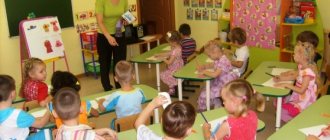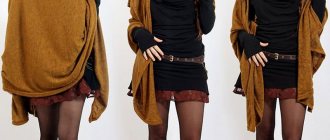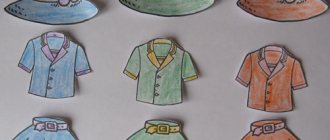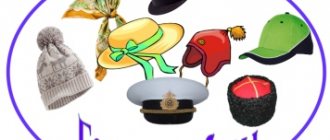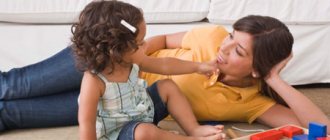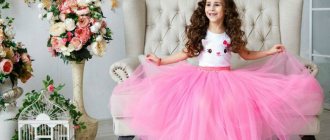Fourth wheel
Target. Development of thinking.
Task. Familiarization with the surroundings (clothes, shoes, hats).
Equipment. Subject pictures with images of clothes, shoes, hats.
Progress of the game
The teacher will put pictures on the typesetting canvas with images of three items of clothing and one pair of shoes or three pairs of shoes and one headdress and invites them to examine and name them. You can invite children to remember poems, nursery rhymes, and riddles about these objects. Then the children are given the task of determining which picture is odd and why.
You can play the game in a similar way by placing on a typesetting canvas three pictures with images of multi-colored clothes and one with images of plain clothes, or three pictures with images of clothes for winter and one picture with images of clothes for summer, etc.
What's missing? Target. Development of visual attention and perception. Task. Familiarization with the surroundings (clothes, shoes, hats).
Equipment. Subject pictures with images of clothes, shoes, hats.
Progress of the game
The teacher will place pictures on the typesetting canvas with images of four to five items of clothing, shoes, and hats, asking them to examine and name them. You can invite children to remember poems, nursery rhymes, and riddles about these objects. Then the children are asked to close their eyes. At this time, the teacher removes one of the pictures. Having opened their eyes, children must determine what is missing.
What changed? Target. Development of visual attention and perception. Task. Familiarization with the surroundings (clothes, shoes, hats).
Equipment. Subject pictures with images of clothes, shoes, hats.
Progress of the game
The teacher will put pictures with images of clothes, shoes, and hats on the typesetting canvas, asking them to look at and name them. You can invite children to remember poems, nursery rhymes, and riddles about these objects. Then the children are asked to close their eyes. At this time, the teacher swaps two pictures or puts another instead of one picture (thin socks instead of woolen socks). Having opened their eyes, children must determine what has changed or which pictures have swapped places.
What appeared? Target. Development of visual attention and perception. Task. Getting to know those around you! (clothes, shoes, hats).
Equipment. Subject pictures with images of clothes, shoes, hats.
Progress of the game
The teacher places pictures with images of four to five items of clothing, shoes, and hats on the typesetting canvas, asking them to examine and name them. You can invite children to remember poems, nursery rhymes, and riddles about these objects. Then the children are asked to close their eyes. At this time, the teacher places another picture on the typesetting canvas. Having opened their eyes, children must determine what object has appeared.
Choose a scheme
Target. Development of sound word analysis skills.
Task. Familiarization with the surroundings (clothes, shoes, hats).
Equipment. Subject pictures with images of a hat, fur coat, jacket, raincoat. Cards with sound patterns of these words.
Progress of the game
The teacher places pictures with images of a hat, fur coat, jacket, and cap on the typesetting canvas. Children look at the pictures and name them. Then the teacher invites the children to take one card with a sound diagram of the word from a bag, chest or container. Children complete the task and then look at the diagrams. Next, they are given the task of putting diagrams under those pictures whose names correspond to the diagrams in terms of sound composition.
Syllabic domino Goal. Improving the skill of syllabic analysis of words.
Equipment. Subject pictures with images of clothes, shoes, hats (scarf, raincoat, fur coat, hat, trousers, dress, leggings, sneakers, mittens, overalls). Cards with images of one, two, three and four squares.
Progress of the game
The teacher will place pictures of clothes, shoes, and hats on the typesetting canvas. Children look at and name them. The teacher puts cards with images of one, two, three and four squares in a row. He explains that the squares represent the number of syllables in the names of objects. Next, children are given the task of arranging pictures with images of clothes, shoes and hats into a square, depending on how many syllables their names are divided into.
Shoes. Cards for activities
Do you know the difference between sandals and sandals?
Or is there a difference between boots and half-boots, Ugg boots and high boots, flip-flops and slates? Nowadays, there are so many types of different shoes that you can’t remember all the names right away. Can you imagine what it’s like for our children! These shoe type cards will help your little ones with shoe classification. Download and play. All shoes are divided into casual and sports shoes.
Oh, yes, there is also medical (shoe covers), industrial (work boots) and specialized sports (boots), but we won’t talk about them.
Let's start with sports shoes.
Sneakers Sneakers
Let's move on to casual shoes. It is divided by seasons.
Let's start with winter shoes. These are warm boots, boots, felt boots, uggs, burkas, high boots.
winter shoes winter shoes winter shoes winter shoes winter shoes winter shoes
In the autumn-spring season, children mostly run around in sneakers, light boots or shoes. For rainy weather there are rubber boots.
demi-season shoes demi-season shoes shoes shoes summer shoes summer shoes summer shoes flip-flops
Source
Exercise poem for studying clothes
And here is a version of the exercise rhyme. It will help you repeat with your child not only the names of items of clothing, but also the colors. Additionally, it will help you concentrate on what you are saying.
Children with (red shirts/blue pants/etc.), Children in (red shirts/blue pants/etc.),
Children with (red shirts/blue pants/etc.), Children in (red shirts/blue pants/etc.),
Please stand up, please stand up. Please stand up, please stand up.
Clap your hands and turn around
Clap your hands and turn around
Then sit down, then sit down. Then sit down, then sit down.
Cards for activities with children learning to classify shoes
Do you know the difference between sandals and sandals? Or is there a difference between boots and half-boots, Ugg boots and high boots, flip-flops and slates? Nowadays, there are so many types of different shoes that you can’t remember all the names right away. Can you imagine what it’s like for our children! These shoe type cards will help your little ones with shoe classification. Download and play.
All shoes are divided into casual and sports shoes.
Oh, yes, there is also medical (shoe covers), industrial (work boots) and specialized sports (boots), but we won’t talk about them.
Let's start with sports shoes.
Its main types are sneakers, half-sneakers and sneakers. Recently, these types of shoes have migrated from sports to everyday life.
The first two cards are high-top sneakers and light low-top sneakers, however, they are also more often called simply sneakers.
SneakersSneakersSneakers
Let's move on to casual shoes. It is divided by seasons.
Let's start with winter shoes. These are warm boots, boots, felt boots, uggs, burkas, high boots.
winter shoeswinter shoeswinter shoeswinter shoeswinter shoeswinter shoes
In the autumn-spring season, children mostly run around in sneakers, light boots or shoes. For rainy weather there are rubber boots.
demi-season shoesdemi-season shoesshoes
Summer shoes - sandals, sandals, slates, flip-flops...
summer shoessummer shoessummer shoes flip flops
The only house shoes left were soft and cozy slippers.
slippers
Download cards: Obuv.zip
Shoes. Thematic cards for kindergarten
This collection contains cards on the topic “Shoes”.
The set consists of 20 cards. The inscriptions on some cards are the same. Let's say there are shoes for a boy and shoes for a girl.
This collection contains cards on the topic “Shoes”.
The set consists of 20 cards. The inscriptions on some cards are the same. Let's say there are shoes for a boy, and shoes for a girl. There are rubber boots, and then there are winter boots. And so on.
Pictures depicting Clothes and Shoes
Pictures depicting casual clothes and shoes, Clothes, Shoes, clothing cards, Shoes cards.
Thematic cards “Clothes”, “Shoes”, Didactic cards “Clothes and Shoes”. Cards depicting various clothes and shoes. Cards for child development, educational cards from the “Clothing” series, educational cards from the “Shoes” series.
Total: 44 cards
Clothes Cards for Children
Shoes Cards for Children
Find out what else a child at this age should know and be able to do.
Clothes pictures for children
Especially for all those who study the topic of clothing, I offer a free download of a selection of my games, cards on the topic: “clothing pictures for children.” Your child will get acquainted with the main types of clothing, learn a little about shoes and what types of shoes there are, in addition, he will learn what clothes to wear and in what weather and, of course, what clothes to wear at what time of year.
Thus, your child will expand his horizons, learn a lot of new and interesting things, develop memory, attentiveness, fine motor skills of his fingers, etc.
This material with clothes for children is intended for children from 1.5 years old who are studying the topic of clothing.
You can download all materials for free. Click on the pictures below to download and print.
A selection of pictures
Dress, skirt, pants and jeans:
Jacket, coat, cap and hat Shirt, shorts, T-shirt and pajamas
Sweater, apron, slippers and mittens
Shoes, socks, gloves and swimsuit
Scarf, belt, handkerchief, boots
Suit, blouse, tie and vest
Shoes
Here you can download a free poster with pictures of a wide variety of shoes for children. Your child will learn that there are types of shoes such as: sandals, mules, heels, ballet flats, clogs, lace-ups, high heels, wedges, platform shoes, slippers, pumps, sandals, rubber sandals, slippers, moccasins, sneakers, boots, rubber boots, leather boots, cowboy boots, hiking boots, sneakers.
Download pictures of shoes:
In addition, here you can download two games on the theme of clothing pictures for children.
The first game is “Clothing pictures for children.”
Before you are four seasons - winter, spring, summer and autumn, as well as different types of clothing that you will need to correlate with a specific time of year.
Ira develops logic, attentiveness, fine motor skills of the fingers, perseverance, and broadens the child’s horizons.
Clothes: T-shirt, jacket, T-shirt, raincoat, fur coat, shorts, pants, swimwear, hat, umbrella, gloves, sneakers, boots, slippers, briefcase, cap.
And another game about clothes and shoes.
Here you need to select and combine the desired weather option and clothing, shoes and accessories that need to be worn and used in this or that weather.
The following types of weather are presented here: cloudy, rainy, snowy, sunny, foggy, rain with thunderstorm, windy.
To download this game, click on the image below. The game is aimed at expanding the child’s horizons, developing logical attention, memory and fine motor skills of the fingers.
Develop your little ones. Good luck in your classes)))
How to teach?
How to teach children to put on shoes and clothes correctly? Pictures or cards with items of clothing come to the aid of mothers. You show your child how shoes should be put on (toes of shoes should not point in different directions) and a shirt (buttons buttoned in a row). Then ask your baby to put on and button up his shirt and shoes in the same way. If you can’t do it right away, buy special trainers for lacing and buttoning skills.
Another educational and stimulating method is to partially dress children. The mother puts the socks on her feet, but not all the way: the baby himself must continue. To prevent your baby from having to struggle with getting dressed for a long time, buy clothes with large fasteners:
- on elastic bands;
- with Velcro.
Clothes with zippers and complicated fastenings are unattractive to little ones because they won't be able to handle them right away. Don’t forget to repeat the names of the wardrobe items while dressing:
- let's put on socks;
- let's fasten the buttons on the shirt;
- Are you wearing tights correctly?
If the process of dressing seems too labor-intensive for mother and baby, try training on simulators: clothes for dolls and toys will help with this. It is easier for children to convey basic concepts in a playful way, so while dressing/undressing toys you can easily teach your child to recognize:
- types of shoes;
- names of wardrobe items.
To ensure that the doll’s clothes are put on correctly, the mother points to the pictures and emphasizes the importance of wearing a dress or panties correctly.
A clear example will help your child quickly learn the necessary skills and, at the same time, learn the names and types of clothes.
The baby will first learn how to dress dolls, and then transfer the acquired skills to practice. You don’t have to worry that your little one in kindergarten will have problems walking!
Clothes pictures for children, cards for kindergarten
Teaching preschoolers is much more effective if a teacher or parent uses visual materials. Beautiful pictures of clothes for children, for example, allow you to:
Properly selected illustrations for children provide half the success of any speech therapy exercise, holding the child’s attention and giving him the necessary “tips.”
General principles of working with pictures
What rules should be followed when using pictures for activities with children? There are not many requirements, but all are important:
You can make an excellent demonstration material on the topic of clothing yourself if you print out the illustrations for this article and glue them to a thick base with tape.
How to use pictures correctly in classes and games
If you want to use clothing cards for lessons, it is important to let the children take a good look at them first.
It is useful to play several games (for attention or logic) with illustrations selected for speech practice, which can then be used in class. This gives children the opportunity to get acquainted with the drawings without haste and ask an adult questions about what they saw. The following techniques will be useful:
After such a preliminary “immersion in the topic,” it will be much easier for children to participate in speech games.
Exercises and games - Clothes in English for children
Match the words with the picture
Match the words with the picture. This is the most obvious game, but it is effective.
Guess who?
Guess who? In the picture there are children dressed in colorful clothes, the child must choose someone and describe in a few words what he is wearing, and you try to guess.
Crossword
Crossword. It is possible that the child will not yet be able to spell the word, but at first you can fill in the empty squares; in this case, the child will be required to provide the correct name for the item of clothing.
Coloring pages
Coloring pages. If your child is a creative person, then he should like various coloring options, with and without captions; from some options you can cut out game cards. Or, let's say, you will describe a thing in English, and the child must find this thing in the picture and color it in the right color.
What am I wearing?
What am I wearing? The child is shown a photograph or picture for a certain time, after which the picture is removed, and the child describes what clothes were shown in the picture.
Paired cards
Paired cards. Prepare two sets of cards with the same pictures, on one the signature will be in English, on the second in Russian. When everything starts to work out quickly, the pictures can be made different, for example, a blue cap of one style, and a red cap of another.
Gallows
Gallows. Surely in childhood many played this game with their parents. It can be very coolly adapted to play with English words. Now you have learned a certain number of words with your child, and now think of a word, write the first letter or letter in the middle of the word, and mark the rest with dashes. Let the child guess the letters or the word, but with your clues, for example, this thing is on you. This game will help you better remember the pronunciation and spelling of words.
